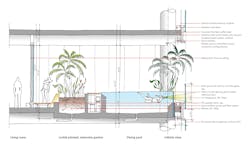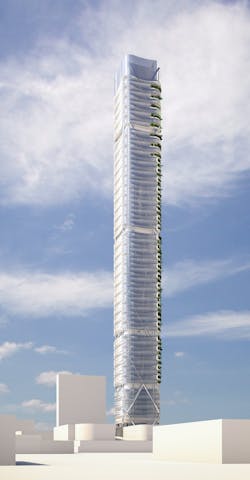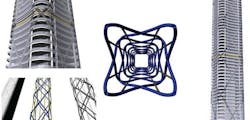The phrase “tall tower” calls to mind sky-high heights, memorable design and sweeping city views. What you usually don’t think about, however, is how the tower’s design could actually improve your physical and mental health.
With city populations increasing around the world, many of us are spending more and more time inside these tall buildings, making their impact on health a crucial issue for billions of people.
CallisonRTKL collaborated with its parent company Arcadis to design a new kind of high-end residential tower that addresses individual well-being. The project stands out for the novel way in which a building’s structural elements and restrained design language, informed by natural lines and organic shapes, play a pivotal role in enhancing wellness.
Defining the relationship between building and body
Innovation in the design of tall buildings occurs incrementally and is often driven by subtle changes in cultural norms, scientific discoveries and technological breakthroughs. It is only recently that we have been able to substantiate the idea of a connection between space and self.
The Biophilia hypothesis—that an instinctive bond exists between humans and other living systems—was first introduced by Edward Wilson in his book “Biophilia” in 1984, and was the first of such substantiated theories. That same year, a breakthrough study on the effects of exposure to green shapes was published in the journal Science, by environmental psychologist Roger Ulrich. This study was the first to use the standards of modern medical research to demonstrate that views to a garden can positively affect patient recovery in hospitals and care facilities.
In recent times, neuroscientists and psychologists who study the effects of architectural spaces on humans have identified how vital signs respond and change with the environment. Cognitive neuroscientist Colin Ellard, author of “Places of the Heart: The Psychogeography of Everyday Life,” uses physical environments and immersive virtual reality to test mood, concentration and stress levels of people in varied surroundings.
Skin conductance sensors, which monitor the sympathetic nervous system, can now show that there is a direct correlation between garden views, sinuous shapes and stress levels. Think about it: Why is green often associated as a calming or soothing color? Or why do people seek out nature to feel a sense of serenity and connection to the self? Exposure to green spaces has a profound and positive effect on a person’s well-being, allowing for self-reflection, tranquility and the discovery of inner peace.
The shape of a building can affect us as well. Rectilinear forms increase stress; sinuous forms reduce it. Oshin Vartanian, a psychologist at the University of Toronto, conducted a study that placed a group of people inside a brain imaging machine that showcased photos of interior design projects with either a curvy or linear aesthetic. The test group was asked to describe each space as “beautiful” or “not beautiful.”
The results revealed that participants overwhelmingly favored spaces with curved furniture, fixtures and floor patterns to their angular counterparts. Most importantly, Vartanian’s brain scans discovered that sinuous designs led to a burst of activity in the anterior cingulate cortex—a cognitive area of the brain known to trigger an emotional reaction—whereas interior spaces bearing sharp corners and straight lines did not. In short, the way our brain is wired comes built in with an emotional connection to rounded forms.
Sometimes, appearances do matter.
A new tower type
The design for CallisonRTKL’s tower typology takes these findings on environmental preferences into account (see figure above). The gentle, curvilinear exoskeleton of this new type follows the sinuous outline of the tower floor plate. The tower celebrates its soft and organic qualities. Lushly landscaped residential gardens are a key element and strengthen positive physiological and psychological responses while honoring natural environments. Vertically suspended steel cables transfer weight so the gardens seemingly float on the building’s corners.
Standing 1,200 feet tall, this new type of residential tower—with 60 levels of apartments on top of a ten-story luxury hotel—makes a powerful statement for the inherent beauty of organic design. Contemporary architecture, informed by recent revelations in neuroscience as well as the natural preferences of the human condition, can now be measured by its ability to serve as a psychological and physiological place of health and well-being.
About the Author: Matthias Olt leads the designs of high-rise, mixed-use commercial, and commercial office projects and is an expert in sustainable technologies and principles. A talented designer with intuitive aesthetic sensibilities, Matthias brings more than 20 years of architectural experience in North America, Asia and Europe. Matthias frequently speaks at industry events and leads firm-wide sustainable design initiatives and programs. His technical specialties are building envelopes, displacement ventilation, and ground source cooling systems.
About the Author
CallisonRTKL
For more than five decades, Callison and RTKL have created some of the world’s most memorable and successful environments for developers, retailers, investors, institutions and public entities. In 2015, our two practices came together under the Arcadis umbrella, expanding our sphere of influence and the depth and breadth of our resources. Our team is comprised of more than 2,000 creative, innovative professionals throughout the world who are committed to advancing our clients’ businesses and enhancing quality of life. Our firm-wide blog covers all aspects of architecture and design. More on our Ideas page. Follow us on Facebook, Instagram, LinkedIn, Twitter, and Vimeo.


